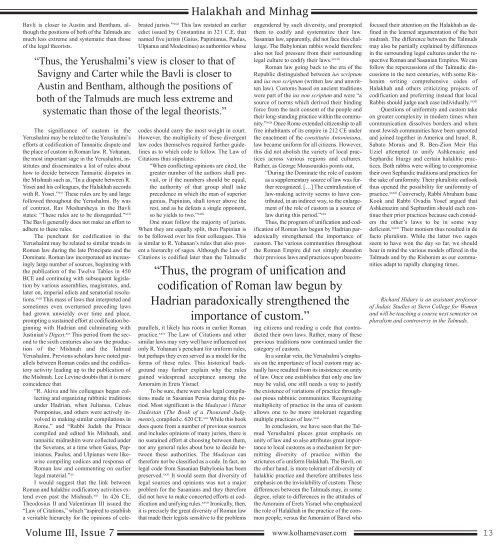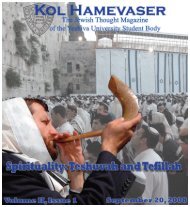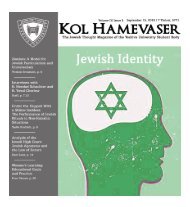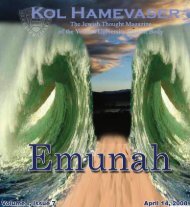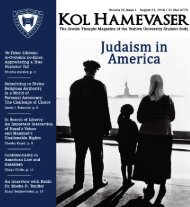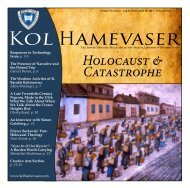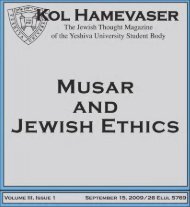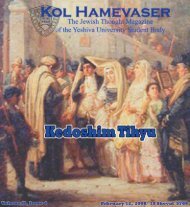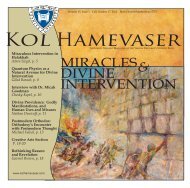You also want an ePaper? Increase the reach of your titles
YUMPU automatically turns print PDFs into web optimized ePapers that Google loves.
Bavli is closer to Austin <strong>and</strong> Bentham, although<br />
the positions of both of the Talmuds are<br />
much less extreme <strong>and</strong> systematic than those<br />
of the legal theorists.<br />
The significance of custom in the<br />
Yerushalmi may be related to the Yerushalmi’s<br />
efforts at codification of Tannaitic dispute <strong>and</strong><br />
the place of custom in Roman law. R. Yohanan,<br />
the most important sage in the Yerushalmi, institutes<br />
<strong>and</strong> disseminates a list of rules about<br />
how to decide between Tannaitic disputes in<br />
the Mishnah such as, “In a dispute between R.<br />
Yosei <strong>and</strong> his colleagues, the <strong>Halakhah</strong> accords<br />
with R. Yosei.” xvi These rules are by <strong>and</strong> large<br />
followed throughout the Yerushalmi. By was<br />
of contrast, Rav Mesharsheya in the Bavli<br />
states: “These rules are to be disregarded.” xvii<br />
The Bavli generally does not make an effort to<br />
adhere to these rules.<br />
The penchant for codification in the<br />
Yerushalmi may be related to similar trends in<br />
Roman law during the late Principate <strong>and</strong> the<br />
Dominate. Roman law incorporated an increasingly<br />
large number of sources, beginning with<br />
the publication of the Twelve Tables in 450<br />
BCE <strong>and</strong> continuing with subsequent legislation<br />
by various assemblies, magistrates, <strong>and</strong>,<br />
later on, imperial edicts <strong>and</strong> senatorial resolutions.<br />
xviii This mass of laws that interpreted <strong>and</strong><br />
sometimes even overturned preceding laws<br />
had grown unwieldy over time <strong>and</strong> place,<br />
prompting a sustained effort at codification beginning<br />
with Hadrian <strong>and</strong> culminating with<br />
Justinian’s Digest. xix This period from the second<br />
to the sixth centuries also saw the production<br />
of the Mishnah <strong>and</strong> the Talmud<br />
Yerushalmi. Previous scholars have noted parallels<br />
between Roman codes <strong>and</strong> the codificatory<br />
activity leading up to the publication of<br />
the Mishnah. Lee Levine doubts that it is mere<br />
coincidence that<br />
“R. Akiva <strong>and</strong> his colleagues began collecting<br />
<strong>and</strong> organizing rabbinic traditions<br />
under Hadrian, when Julianus, Celsus<br />
Pomponius, <strong>and</strong> others were actively involved<br />
in making similar compilations in<br />
Rome,” <strong>and</strong> “Rabbi Judah the Prince<br />
compiled <strong>and</strong> edited his Mishnah, <strong>and</strong><br />
tannaitic midrashim were collected under<br />
the Severans, at a time when Gaius, Papinianus,<br />
Paulus, <strong>and</strong> Ulpianus were likewise<br />
compiling codices <strong>and</strong> responsa of<br />
Roman law <strong>and</strong> commenting on earlier<br />
legal material.” xx<br />
I would suggest that the link between<br />
Roman <strong>and</strong> halakhic codificatory activities extend<br />
even past the Mishnah. xxi In 426 CE,<br />
Theodosius II <strong>and</strong> Valentinian III issued the<br />
“Law of Citations,” which “aspired to establish<br />
a veritable hierarchy for the opinions of cele-<br />
<strong>Halakhah</strong> <strong>and</strong> <strong>Minhag</strong><br />
brated jurists.” xxii This law restated an earlier<br />
edict issued by Constantine in 321 C.E. that<br />
named five jurists (Gaius, Papinianus, Paulus,<br />
Ulpianus <strong>and</strong> Modestinus) as authorities whose<br />
“Thus, the Yerushalmi’s view is closer to that of<br />
Savigny <strong>and</strong> Carter while the Bavli is closer to<br />
Austin <strong>and</strong> Bentham, although the positions of<br />
both of the Talmuds are much less extreme <strong>and</strong><br />
systematic than those of the legal theorists.”<br />
codes should carry the most weight in court.<br />
However, the multiplicity of these divergent<br />
law codes themselves required further guidelines<br />
as to which code to follow. The Law of<br />
Citations thus stipulates:<br />
“When conflicting opinions are cited, the<br />
greater number of the authors shall prevail,<br />
or if the numbers should be equal,<br />
the authority of that group shall take<br />
precedence in which the man of superior<br />
genius, Papinian, shall tower above the<br />
rest, <strong>and</strong> as he defeats a single opponent,<br />
so he yields to two.” xxiii<br />
One must follow the majority of jurists.<br />
When they are equally split, then Papinian is<br />
to be followed over his four colleagues. This<br />
is similar to R. Yohanan’s rules that also present<br />
a hierarchy of sages. Although the Law of<br />
Citations is codified later than the Talmudic<br />
parallels, it likely has roots in earlier Roman<br />
practice. xxiv The Law of Citations <strong>and</strong> other<br />
similar laws may very well have influenced not<br />
only R. Yohanan’s penchant for uniform rules,<br />
but perhaps they even served as a model for the<br />
forms of these rules. This historical background<br />
may further explain why the rules<br />
gained widespread acceptance among the<br />
Amoraim in Erets Yisrael.<br />
To be sure, there were also legal compilations<br />
made in Sasanian Persia during this period.<br />
Most significant is the Madayan i Hazar<br />
Dadestan (The Book of a Thous<strong>and</strong> Judgments),<br />
compiled c. 620 CE. xxv While this book<br />
does quote from a number of previous sources<br />
<strong>and</strong> includes opinions of many jurists, there is<br />
no sustained effort at choosing between them,<br />
nor any general rules about how to decide between<br />
these authorities. The Madayan can<br />
therefore not be classified as a code. In fact, no<br />
legal code from Sasanian Babylonia has been<br />
preserved. xxvi It would seem that diversity of<br />
legal sources <strong>and</strong> opinions was not a major<br />
problem for the Sasanians <strong>and</strong> they therefore<br />
did not have to make concerted efforts at codification<br />
<strong>and</strong> unifying rules. xxvii Ironically, then,<br />
it is precisely the great diversity of Roman law<br />
that made their legists sensitive to the problems<br />
engendered by such diversity, <strong>and</strong> prompted<br />
them to codify <strong>and</strong> systematize their law.<br />
Sasanian law, apparently, did not face this challenge.<br />
The Babylonian rabbis would therefore<br />
also not feel pressure from their surrounding<br />
legal culture to codify their laws. xxviii<br />
Roman law going back to the era of the<br />
Republic distinguished between ius scriptum<br />
<strong>and</strong> ius non scriptum (written law <strong>and</strong> unwritten<br />
law). Customs based on ancient traditions<br />
were part of the ius non scriptum <strong>and</strong> were “a<br />
source of norms which derived their binding<br />
force from the tacit consent of the people <strong>and</strong><br />
their long-st<strong>and</strong>ing practice within the community.”<br />
xxix Once Rome extended citizenship to all<br />
free inhabitants of its empire in 212 CE under<br />
the enactment of the constitutio Antoniniana,<br />
law became uniform for all citizens. However,<br />
this did not abolish the variety of local practices<br />
across various regions <strong>and</strong> cultures.<br />
Rather, as George Mousourakis points out,<br />
“During the Dominate the role of custom<br />
as a supplementary source of law was further<br />
recognized. […] The centralization of<br />
law-making activity seems to have contributed,<br />
in an indirect way, to the enlargement<br />
of the role of custom as a source of<br />
law during this period.” xxx<br />
Thus, the program of unification <strong>and</strong> codification<br />
of Roman law begun by Hadrian paradoxically<br />
strengthened the importance of<br />
custom. The various communities throughout<br />
the Roman Empire did not simply ab<strong>and</strong>on<br />
their previous laws <strong>and</strong> practices upon becom-<br />
“Thus, the program of unification <strong>and</strong><br />
codification of Roman law begun by<br />
Hadrian paradoxically strengthened the<br />
importance of custom.”<br />
ing citizens <strong>and</strong> reading a code that contradicted<br />
their own laws. Rather, many of these<br />
previous traditions now continued under the<br />
category of custom.<br />
In a similar vein, the Yerushalmi’s emphasis<br />
on the importance of local custom may actually<br />
have resulted from its insistence on unity<br />
of law. Once one establishes that only one law<br />
may be valid, one still needs a way to justify<br />
the existence of variations of practice throughout<br />
pious rabbinic communities. Recognizing<br />
multiplicity of practice in the area of custom<br />
allows one to be more intolerant regarding<br />
multiple practices of law. xxxi<br />
In conclusion, we have seen that the Talmud<br />
Yerushalmi places great emphasis on<br />
unity of law <strong>and</strong> so also attributes great importance<br />
to local customs as a mechanism for permitting<br />
diversity of practice within the<br />
strictures of a uniform <strong>Halakhah</strong>. The Bavli, on<br />
the other h<strong>and</strong>, is more tolerant of diversity of<br />
halakhic practice <strong>and</strong> therefore attributes less<br />
emphasis on the inviolability of custom. These<br />
differences between the Talmuds may, in some<br />
degree, relate to differences in the attitudes of<br />
the Amoraim of Erets Yisrael who emphasized<br />
the role of <strong>Halakhah</strong> in the practice of the common<br />
people, versus the Amoraim of Bavel who<br />
Volume III, Issue 7 www.kolhamevaser.com<br />
focused their attention on the <strong>Halakhah</strong> as defined<br />
in the learned argumentation of the beit<br />
midrash. The difference between the Talmuds<br />
may also be partially explained by differences<br />
in the surrounding legal cultures under the respective<br />
Roman <strong>and</strong> Sasanian Empires. We can<br />
follow the repercussions of the Talmudic discussions<br />
in the next centuries, with some Rishonim<br />
writing comprehensive codes of<br />
<strong>Halakhah</strong> <strong>and</strong> others criticizing projects of<br />
codification <strong>and</strong> preferring instead that local<br />
Rabbis should judge each case individually. xxxii<br />
Questions of uniformity <strong>and</strong> custom take<br />
on greater complexity in modern times when<br />
communication dissolves borders <strong>and</strong> when<br />
most Jewish communities have been uprooted<br />
<strong>and</strong> joined together in America <strong>and</strong> Israel. R.<br />
Sabato Morais <strong>and</strong> R. Ben-Zion Meir Hai<br />
Uziel attempted to unify Ashkenazic <strong>and</strong><br />
Sephardic liturgy <strong>and</strong> certain halakhic practices.<br />
Both rabbis were willing to compromise<br />
their own Sephardic traditions <strong>and</strong> practices for<br />
the sake of uniformity. Their pluralistic outlook<br />
thus opened the possibility for uniformity of<br />
practice. xxxiii Conversely, Rabbi Abraham Isaac<br />
Kook <strong>and</strong> Rabbi Ovadia Yosef argued that<br />
Ashkenazim <strong>and</strong> Sephardim should each continue<br />
their prior practices because each considers<br />
the other’s laws to be in some way<br />
deficient. xxxiv Their monism thus resulted in de<br />
facto pluralism. While the latter two sages<br />
seem to have won the day so far, we should<br />
bear in mind the various models offered in the<br />
Talmuds <strong>and</strong> by the Rishonim as our communities<br />
adapt to rapidly changing times.<br />
Richard Hidary is an assistant professor<br />
of Judaic Studies at Stern College for Women<br />
<strong>and</strong> will be teaching a course next semester on<br />
pluralism <strong>and</strong> controversy in the Talmuds.<br />
13


